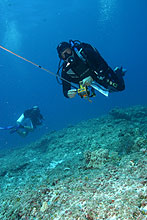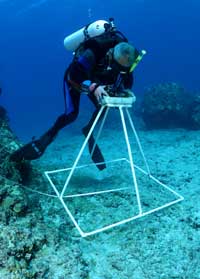NOWRAMP
2002
Rapid
Ecological Assessment
Posted by Mark Heckman, Educator, Waikiki Aquarium/ University
of Hawai’i – Manoa
Rapid
Ecological Assessments are "snapshots" of the
state of the reef. At each stop in the Northwestern Hawaiian
Islands, "REA" teams continue the work of finding
new sites and documenting the fish, algae, invertebrates
and corals at that site. Teams take a GPS (global positioning
satellite) reading in decimal degrees on each site so they
can return in later years. Here is how it works.
 Fish
Teams
Fish
Teams
Have you ever tried to count, identify and size every fish
at your favorite snorkel site? It is not easy - fish move.
Try the method outlined below and see if it works for you.
It sounds easier than it is. Fish counters need to be fast,
accurate and not count the same fish twice.
Like
all members of the REA teams, the members of the fish teams
have trained for years to do these counts. They study the
fish id's, confer with each other when they are in doubt,
check their size estimates against reality, and have all
had extensive experience before starting on this cruise.
Into
the water first, the fish team lay three 25 meter transect
lines on the bottom. As they set the line they count all
fish greater than or equal to 20 centimeters (~ 8 inches)
within 2 meters on each side of the line. This first count
includes the larger mobile fish that may swim off as divers
approach. This can include the 60 - 100 pound jacks and
the 4 - 8 foot sharks. On the return, the crew does a detailed
count and size estimation of the smaller fish (less than
20 centimeters). They record their data on special underwater
slates.
A
third diver does not swim (which causes some disturbance)
but does four stationary point counts of a imaginary cylinder
10 meters in radius for five minutes. This count includes
larger more mobile fish (> or = to 25 centimeters, or
~ 10 inches). After each transect (three per site, three
dives a day), the fish team does a search of the nearby
reef for any rare or unusual species not observed on transects
or stationary point counts.
 Team
Algae
Team
Algae
It sounds easy; after all, algae do not swim off while being
counted. However, one characteristic of tropical reefs is
that there are many grazers (herbivores) eating the seaweeds
(or "limu" in Hawaiian) year round. Many tropical
algal species are small, hidden, and hard to identify.
The
algae team works its way along the transect line with a
special camera, taking 6 photos along each of the 25 meter
lines for later characterization of the reef. One of the
divers records what is being photographed by writing the
names and abundance of the species on a slate. In high surge
conditions, both divers are needed to steady the camera.
At
each stop, they pick reference samples of the seaweed to
identify. Many of these identifications will require looking
at microscopic features, and talking to other experts. There
are over 400 species of algae in Hawai'i; most no bigger
than the length of your hand, some thin as bits of hair
or as small as a tiny scrap of paper.
The
Invertebrate Team
This team seems to be up the latest each night, often still
working at midnight or beyond, while the other teams are
finally shutting down before the dives the next day. Our
dive safety officer has to keep a close eye on everyone's
schedule to keep them rested enough to be safe.
 The
"invertebrates" actually include most of the animal
life on earth. The vertebrates (fish, seals, turtles, birds,
us) capture our eye and are really rather easy to identify
in comparison. Marine invertebrates include the sponges
(Porifera), corals, sea anemones, jellies, hydroids, siphoniphores,
etc. (Cnidaria), worms and worm-like animals (Annelida,
Platyhelminthes, Nemertea, Echiurida, Sipuncula, Hemichordata),
the chitons, snails, sea slugs, clams, octopus, squid, etc.
(Molluscs), the barnacles, shrimps, crabs, lobsters, insects,
etc. (Arthropoda), the brittlestars, seastars, sea urchins,
sea cucumbers, etc. (Echinodermata), and more. A scientist
may spend an entire lifetime studying just one part of one
of these groups.
The
"invertebrates" actually include most of the animal
life on earth. The vertebrates (fish, seals, turtles, birds,
us) capture our eye and are really rather easy to identify
in comparison. Marine invertebrates include the sponges
(Porifera), corals, sea anemones, jellies, hydroids, siphoniphores,
etc. (Cnidaria), worms and worm-like animals (Annelida,
Platyhelminthes, Nemertea, Echiurida, Sipuncula, Hemichordata),
the chitons, snails, sea slugs, clams, octopus, squid, etc.
(Molluscs), the barnacles, shrimps, crabs, lobsters, insects,
etc. (Arthropoda), the brittlestars, seastars, sea urchins,
sea cucumbers, etc. (Echinodermata), and more. A scientist
may spend an entire lifetime studying just one part of one
of these groups.
Once
in the water, one of the "Invert" team starts
down the transect line with a video camera. This will give
a general record of non- or slow-moving surface invertebrates
like the corals and urchins. Next the team physically counts
all of the macro invertebrates one meter to each side of
the transect. A video camera is still no match for an actual
diver.
Following
the invertebrate diver is a coral specialist. This person
will record types and numbers of coral colonies (again,
not easy in the field), and will note any health issues,
such as coral bleaching (a sign of stress), or coral diseases
(still poorly documented and studied). After examining at
least two transects, the invert team will spend additional
time surveying the area for unique or unusual species. They
will also collect some rubble to break apart for hidden
animals.
Things
to try:
Try
a simple REA of an area near your house or school, perhaps
your own lawn. Pick an "easy" site and a difficult
site. There are several ways to do this. We suggest putting
your quadrats
on a transect line. Remember to have someone count the birds
above early on (most similar to the fish counts of the REAs).
On
land, you may need to extend your range somewhat (no fish,
so try and find an area with a lot of birds). You may need
to turn over rocks and stumps to find your invertebrates
as well as sweeping the bushes with insect nets. You may
want to identify plants to species. For instance, what type
of grass do you have? A sample of your grass can be taken
to a local nursery for identification. List and count everything
- numbers and sizes are needed if you are going to compare
the sites. You can make a transect line and survey everything
to several meters to each side, or do smaller samples and
extrapolate.
If
you can identify the animal in the field without capturing
it, that is much preferred. If it is windy or rainy, no
problem (recommended for older students only) - science
divers work in strong waves, murky and shark filled waters,
cold or warm - welcome to the world of field science. Discuss
working in "poor" conditions versus "good"
conditions. Some habitats may be windy or rainy by nature
- it is part of what they are.
Try
an REA of your or your student's desks. Limit the time available
for this (just as our divers are limited in the amount of
bottom time and air that they have). How many keys and of
what type are on your keyboard? Inventory every book, pencil
(to kind and size). This can be very tedious for those of
us that are organizationally challenged. Now consider that
nature is even more complex. Discuss why it is important
for REA teams to practice before going into the field.
References:
Expedition scientists Dr. Alan Friedlander, Dr. Karla
McDermid, Dr. Duane Minton, Anuschka Faucci, Kanekoa Shultz,
Kimberly Peyton, and Brooke Stuercke.
<<back